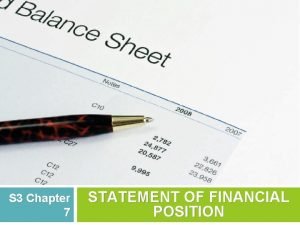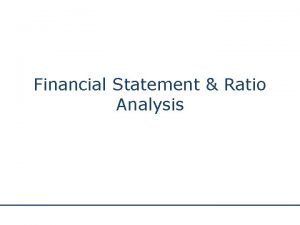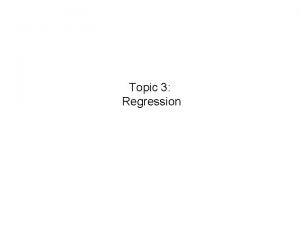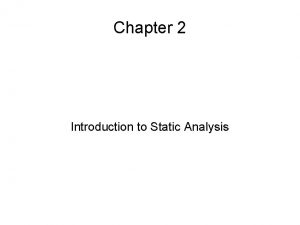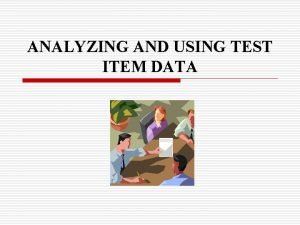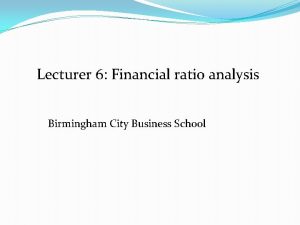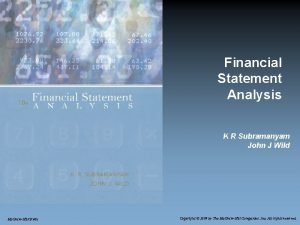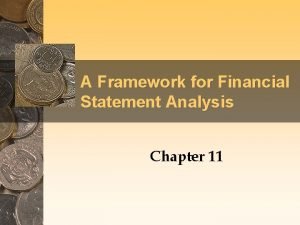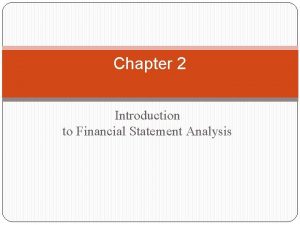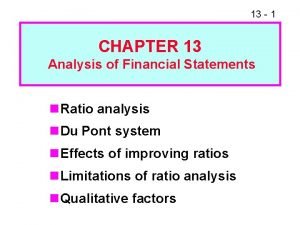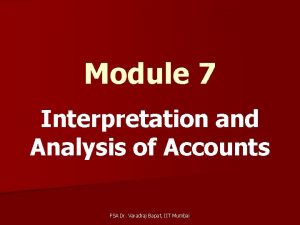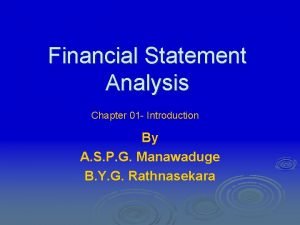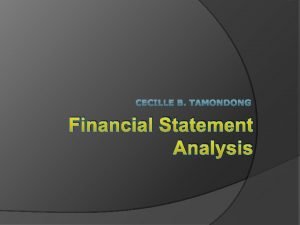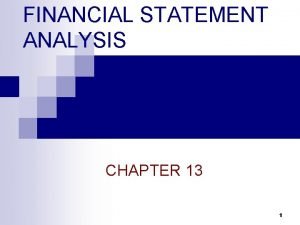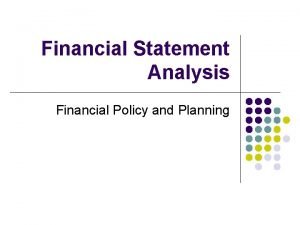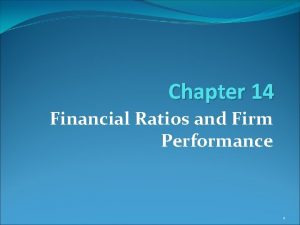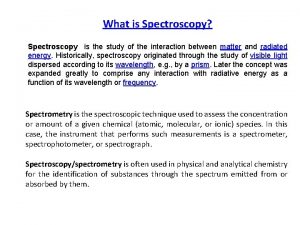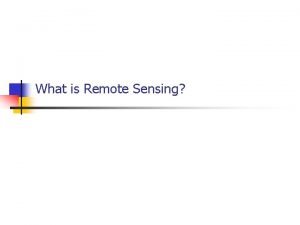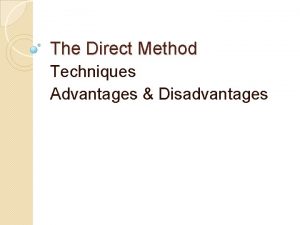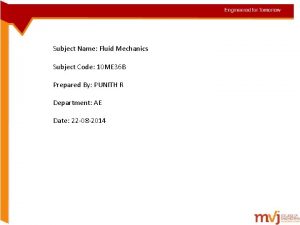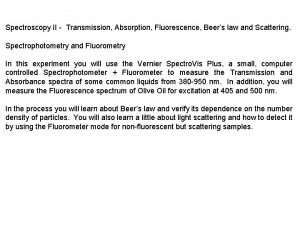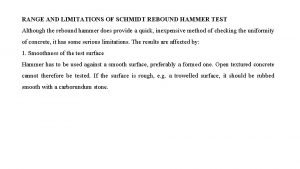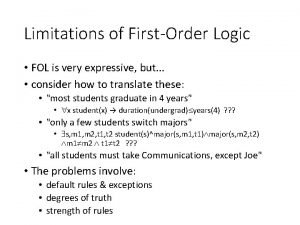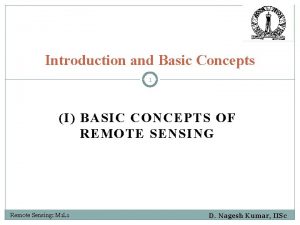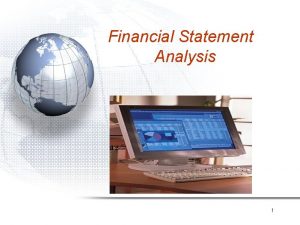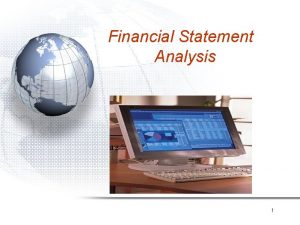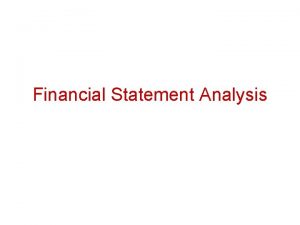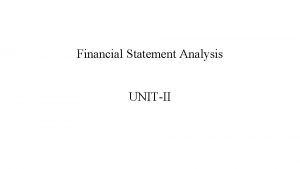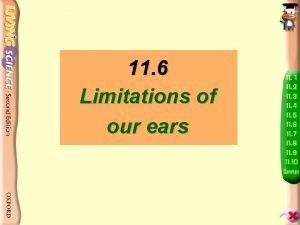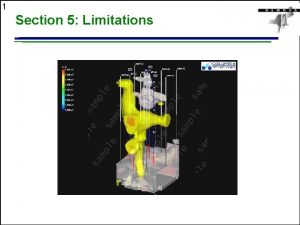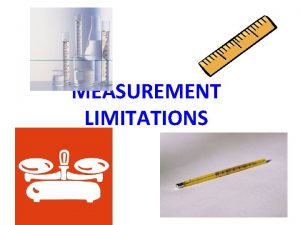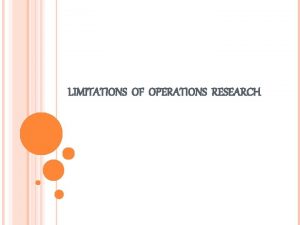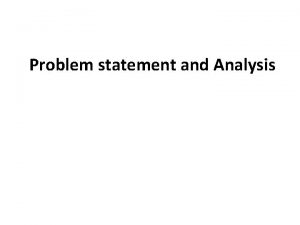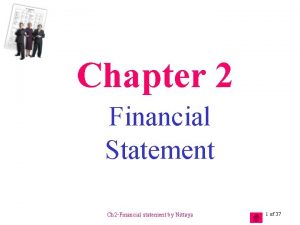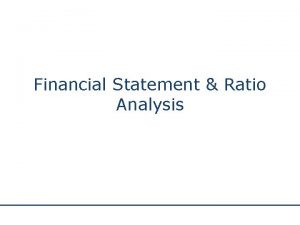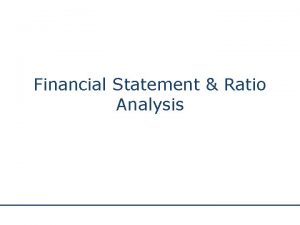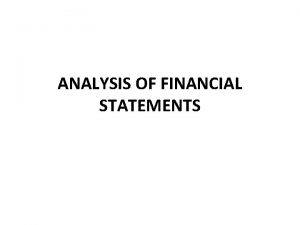Financial Statement Analysis Limitations of Financial Statement Analysis



































































- Slides: 67

Financial Statement Analysis

Limitations of Financial Statement Analysis Differences in accounting methods between companies sometimes make comparisons difficult. We use the LIFO method to value inventory. We use the average cost method to value inventory.

Limitations of Financial Statement Analysis Industry trends Technological changes Changes within the company Consumer tastes Economic factors Analysts should look beyond the ratios.

Statements in Comparative and Common. Size Form Dollar and percentage changes on statements An item on a financial statement has little meaning by itself. The meaning of the numbers can be enhanced by drawing comparisons. Common-size statements Ratios

Dollar and Percentage Changes on Statements Horizontal analysis (or trend analysis) shows the changes between years in the financial data in both dollar and percentage form.

Horizontal Analysis Example The following slides illustrate a horizontal analysis of Clover Corporation’s December 31, 2005 and 2004, comparative balance sheets and comparative income statements.

Horizontal Analysis

Horizontal Analysis Calculating Change in Dollar Amounts Dollar Change = Current Year Figure – Base Year Figure The dollar amounts for 2004 become the “base” year figures.

Horizontal Analysis Calculating Change as a Percentage Change = Dollar Change Base Year Figure × 100%

Horizontal Analysis $12, 000 – $23, 500 = $(11, 500) ($11, 500 ÷ $23, 500) × 100% = 48. 9%

Horizontal Analysis

Horizontal Analysis We could do this for the liabilities & stockholders’ equity, but now let’s look at the income statement accounts.

Horizontal Analysis

Horizontal Analysis

Horizontal Analysis Sales increased by 8. 3% yet net income decreased by 21. 9%.

Horizontal Analysis There were increases in both cost of goods sold (14. 3%) and operating expenses (2. 1%). These increased costs more than offset the increase in sales, yielding an overall decrease in net income.

Trend Percentages Trend percentages state several years’ financial data in terms of a base year, which equals 100 percent.

Trend Analysis Trend = Percentage Current Year Amount Base Year Amount × 100%

Trend Analysis Example Look at the income information for Berry Products for the years 2001 through 2005. We will do a trend analysis on these amounts to see what we can learn about the company.

Trend Analysis Berry Products Income Information For the Years Ended December 31 The base year is 2001, and its amounts will equal 100%.

Trend Analysis Berry Products Income Information For the Years Ended December 31 2002 Amount ÷ 2001 Amount × 100% ( $290, 000 ÷ $275, 000 ) × 100% = 105% ( $198, 000 ÷ $190, 000 ) × 100% = 104% ( $ 92, 000 ÷ $ 85, 000 ) × 100% = 108%

Trend Analysis Berry Products Income Information For the Years Ended December 31 By analyzing the trends for Berry Products, we can see that cost of goods sold is increasing faster than sales, which is slowing the increase in gross margin.

Trend Analysis We can use the trend percentages to construct a graph so we can see the trend over time.

Common-Size Statements Vertical analysis focuses on the relationships among financial statement items at a given point in time. A common-size financial statement is a vertical analysis in which each financial statement item is expressed as a percentage.

Common-Size Statements In income statements, all items are usually expressed as a percentage of sales.

Gross Margin Percentage = Gross Margin Sales This measure indicates how much of each sales dollar is left after deducting the cost of goods sold to cover expenses and provide a profit.

Common-Size Statements In balance sheets, all items are usually expressed as a percentage of total assets.

Common-Size Statements Common-size financial statements are particularly useful when comparing data from different companies.

Common-Size Statements Example Let’s take another look at the information from the comparative income statements of Clover Corporation for 2005 and 2004. This time let’s prepare common-size statements.

Common-Size Statements Sales is usually the base and is expressed as 100%.

Common-Size Statements 2005 Cost ÷ 2005 Sales × 100% ( $360, 000 ÷ $520, 000 ) × 100% = 69. 2% 2004 Cost ÷ 2004 Sales × 100% ( $315, 000 ÷ $480, 000 ) × 100% = 65. 6%

Common-Size Statements What conclusions can we draw?

Quick Check Which of the following statements describes horizontal analysis? a. A statement that shows items appearing on it in percentage and dollar form. b. A side-by-side comparison of two or more years’ financial statements. c. A comparison of the account balances on the current year’s financial statements. d. None of the above.

Quick Check Which of the following statements describes horizontal analysis? a. A statement that shows items appearing on it in percentage and dollar form. b. A side-by-side comparison of two or more years’ financial statements. c. Horizontal A comparison of the account analysis shows the balances changes on the current between yearsyear’s in thefinancialstatements. data in both d. Nonedollar of theand above. percentage form.

Now, let’s look at Norton Corporation’s 2005 and 2004 financial statements.




Ratio Analysis – The Common Stockholder The ratios that are of the most interest to stockholders include those ratios that focus on net income, dividends, and stockholders’ equities.

Earnings Per Share Earnings per Share = Net Income – Preferred Dividends Average Number of Common Shares Outstanding Whenever a ratio divides an income statement balance by a balance sheet balance, the average for the year is used in the denominator. Earnings form the basis for dividend payments and future increases in the value of shares of stock.

Earnings Per Share Earnings per Share = Net Income – Preferred Dividends Average Number of Common Shares Outstanding $53, 690 – $0 ($17, 000 + $27, 400)/2 = $2. 42 This measure indicates how much income was earned for each share of common stock outstanding.

Price-Earnings Ratio = = Market Price Per Share Earnings Per Share $20. 00 $2. 42 = 8. 26 times A higher price-earnings ratio means that investors are willing to pay a premium for a company’s stock because of optimistic future growth prospects.

Dividend Payout Ratio = = Dividends Per Share Earnings Per Share $2. 00 $2. 42 = 82. 6% This ratio gauges the portion of current earnings being paid out in dividends. Investors seeking dividends (market price growth) would like this ratio to be large (small).

Dividend Yield Ratio = = Dividends Per Share Market Price Per Share $2. 00 $20. 00 = 10. 00% This ratio identifies the return, in terms of cash dividends, on the current market price of the stock.

Return on Total Assets Return on = Total Assets Net Income + [Interest Expense × (1 – Tax Rate)] Average Total Assets Return on = Total Assets $53, 690 +[$7, 300 × (1 –. 30)] ($300, 000 + $346, 390) ÷ 2 = 18. 19% Adding interest expense back to net income enables the return on assets to be compared for companies with different amounts of debt or over time for a single company that has changed its mix of debt and equity.

Return on Common Stockholders’ Equity Return on Common = Net Income – Preferred Dividends Stockholders’ Equity Average Stockholders’ Equity Return on Common = $53, 690 – $0 = 25. 91% Stockholders’ Equity ($180, 000 + $234, 390) ÷ 2 This measure indicates how well the company used the owners’ investments to earn income.

Financial Leverage Financial leverage results from the difference between the rate of return the company earns on investments in its own assets and the rate of return that the company must pay its creditors. Return on investment in > assets Fixed rate of return on borrowed funds Positive = financial leverage Return on investment in < assets Fixed rate of return on borrowed funds Negative = financial leverage

Quick Check Which of the following statements is true? a. Negative financial leverage is when the fixed return to a company’s creditors and preferred stockholders is greater than the return on total assets. b. Positive financial leverage is when the fixed return to a company’s creditors and preferred stockholders is greater than the return on total assets. c. Financial leverage is the expression of several years’ financial data in percentage form in terms of a base year.

Quick Check Which of the following statements is true? a. Negative financial leverage is when the fixed return to a company’s creditors and preferred stockholders is greater than the return on total assets. b. Positive financial leverage is when the fixed return to a company’s creditors and preferred stockholders is greater than the return on total assets. c. Financial leverage is the expression of several years’ financial data in percentage form in terms of a base year.

Book Value Per Share Book Value per Share = Book Value per Share Common Stockholders’ Equity Number of Common Shares Outstanding = $234, 390 27, 400 = $ 8. 55 This ratio measures the amount that would be distributed to holders of each share of common stock if all assets were sold at their balance sheet carrying amounts and if all creditors were paid off.

Book Value Per Share Book Value per Share = Book Value per Share Common Stockholders’ Equity Number of Common Shares Outstanding = $234, 390 27, 400 = $ 8. 55 Notice that the book value per share of $8. 55 does not equal the market value per share of $20. This is because the market price reflects expectations about future earnings and dividends, whereas the book value per share is based on historical cost.

Ratio Analysis – The Short–Term Creditor Short-term creditors, such as suppliers, want to be paid on time. Therefore, they focus on the company’s cash flows and working capital.

Working Capital The excess of current assets over current liabilities is known as working capital. Working capital is not free. It must be financed with long-term debt and equity.

Working Capital

Current Ratio = Current Assets Current Liabilities The current ratio measures a company’s short-term debt paying ability. A declining ratio may be a sign of deteriorating financial condition, or it might result from eliminating obsolete inventories.

Current Ratio = = Current Assets Current Liabilities $65, 000 $42, 000 = 1. 55

Acid-Test (Quick) Ratio Acid-Test = Ratio Quick Assets Current Liabilities Acid-Test $50, 000 = = 1. 19 Ratio $42, 000 Quick assets include Cash, Marketable Securities, Accounts Receivable and current Notes Receivable. This ratio measures a company’s ability to meet obligations without having to liquidate inventory.

Accounts Receivable Turnover = Sales on Account Average Accounts Receivable Accounts $494, 000 = 26. 7 times Receivable = ($17, 000 + $20, 000) ÷ 2 Turnover This ratio measures how many times a company converts its receivables into cash each year.

Average Collection Period Average 365 Days Collection = Accounts Receivable Turnover Period Average Collection = Period 365 Days 26. 7 Times = 13. 67 days This ratio measures, on average, how many days it takes to collect an account receivable.

Inventory Turnover = Cost of Goods Sold Average Inventory This ratio measures how many times a company’s inventory has been sold and replaced during the year. If a company’s inventory turnover Is less than its industry average, it either has excessive inventory or the wrong sorts of inventory.

Inventory Turnover = Cost of Goods Sold Average Inventory $140, 000 = = 12. 73 times ($10, 000 + $12, 000) ÷ 2

Average Sale Period Average = Sale Period = 365 Days Inventory Turnover 365 Days 12. 73 Times This ratio measures how many days, on average, it takes to sell the inventory. = 28. 67 days

Ratio Analysis – The Long–Term Creditor Long-term creditors are concerned with a company’s ability to repay its loans over the long-run. This is also referred to as net operating income.

Times Interest Earned Ratio Times Interest = Earned Earnings before Interest Expense and Income Taxes Interest Expense $84, 000 = 11. 51 times $7, 300 This is the most common measure of a company’s ability to provide protection for its longterm creditors. A ratio of less than 1. 0 is inadequate.

Debt-to-Equity Ratio Debt–to– Total Liabilities Equity = Stockholders’ Equity Ratio This ratio indicates the relative proportions of debt to equity on a company’s balance sheet. Stockholders like a lot of debt if the company can take advantage of positive financial leverage. Creditors prefer less debt and more equity because equity represents a buffer of protection.

Debt-to-Equity Ratio Debt–to– Total Liabilities Equity = Stockholders’ Equity Ratio Debt–to– Equity = Ratio $112, 000 $234, 390 = 0. 48

 Internal users of financial reports
Internal users of financial reports Tangible net worth
Tangible net worth Normalised earnings limitations
Normalised earnings limitations Limitations of financial reporting
Limitations of financial reporting Disadvantages of regression analysis
Disadvantages of regression analysis Limitations of static analysis
Limitations of static analysis Zero discriminating power
Zero discriminating power Limitations of ratios analysis
Limitations of ratios analysis Summary of ratio analysis
Summary of ratio analysis Kr subramanyam
Kr subramanyam Chapter 14 financial statement analysis solutions
Chapter 14 financial statement analysis solutions Financial statement analysis framework
Financial statement analysis framework Chapter 2 financial statement analysis solutions
Chapter 2 financial statement analysis solutions Objectives of financial statement analysis
Objectives of financial statement analysis Chapter 13 financial statement analysis
Chapter 13 financial statement analysis Horizontal analysis interpretation
Horizontal analysis interpretation Introduction of financial statement analysis
Introduction of financial statement analysis Financial analysis for banks
Financial analysis for banks Solvency investopedia
Solvency investopedia Analysis of financial statements
Analysis of financial statements Chapter 1 overview of financial statement analysis
Chapter 1 overview of financial statement analysis Financial statement analysis and planning
Financial statement analysis and planning Chapter 14 financial statement analysis
Chapter 14 financial statement analysis Non-financial methods of motivation
Non-financial methods of motivation English
English Lambert beer law and its limitations
Lambert beer law and its limitations N-rays
N-rays Lambert beer law and its limitations
Lambert beer law and its limitations Darcy law
Darcy law Limitations of ict
Limitations of ict Value and limitations ib history
Value and limitations ib history Limitations of study examples
Limitations of study examples Disadvantages of direct method of teaching
Disadvantages of direct method of teaching Biopsychosocial model limitations
Biopsychosocial model limitations Criticism of accelerator theory of investment
Criticism of accelerator theory of investment Langmuir adsorption isotherm equation
Langmuir adsorption isotherm equation Limitations of bernoulli's theorem
Limitations of bernoulli's theorem Limitation of distributed system
Limitation of distributed system Beer's law fluorescence
Beer's law fluorescence Limitations of recursive descent parser
Limitations of recursive descent parser Example of output in conceptual framework
Example of output in conceptual framework Schmidt rebound hammer test
Schmidt rebound hammer test Limitations of qualitative research
Limitations of qualitative research Limitations of punnett squares in large populations
Limitations of punnett squares in large populations Flory krigbaum theory
Flory krigbaum theory Examples of functional limitations
Examples of functional limitations What is the weakness of qualitative research
What is the weakness of qualitative research Limitations of profit maximization
Limitations of profit maximization Limitations of finite state machine
Limitations of finite state machine Pros and cons of nmap
Pros and cons of nmap Semaphores vs monitors
Semaphores vs monitors 4 bit processor
4 bit processor Limitation of people as media
Limitation of people as media Oikonomikos meaning
Oikonomikos meaning Dpt test procedure
Dpt test procedure Port knocking software
Port knocking software Molecular dynamics limitations
Molecular dynamics limitations Fol in ai
Fol in ai Definition of trait theory of leadership
Definition of trait theory of leadership Limitations of economics
Limitations of economics Limitations of remote sensing
Limitations of remote sensing Biopsychosocial model limitations
Biopsychosocial model limitations Acid base strength and hardness and softness
Acid base strength and hardness and softness Principle and application of flame photometry
Principle and application of flame photometry Electronic spectra of transition metal complexes
Electronic spectra of transition metal complexes Limitations of bernoulli's equation
Limitations of bernoulli's equation What are the limitations of applied linguistics
What are the limitations of applied linguistics New critical analysis
New critical analysis
